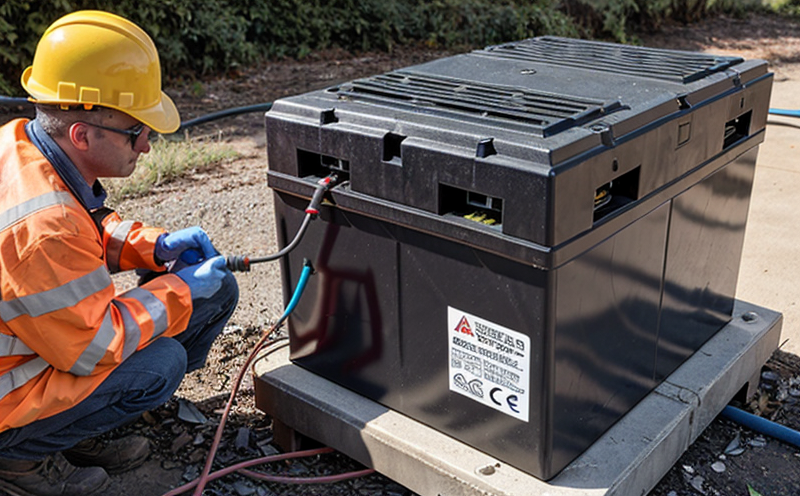IEC 60254-3 Lead-Acid Battery Cycle Life Testing for Traction Applications
The International Electrotechnical Commission (IEC) standard IEC 60254-3 is a pivotal document that establishes the protocols and methods for testing lead-acid batteries used in traction applications. These batteries are critical components in various sectors such as automotive, railway transport, and energy storage systems where durability and reliability are paramount.
The primary focus of this service is to evaluate the cycle life of lead-acid batteries under conditions that mimic real-world operational stress. Cycle life testing is crucial for ensuring that these batteries can withstand numerous charge-discharge cycles without degradation in performance or safety. This service involves a series of rigorous tests designed to simulate the operational environment, thereby providing insights into the battery's longevity and reliability.
The test methodology outlined in IEC 60254-3 is comprehensive and includes both laboratory-based and field-test scenarios. The laboratory tests provide controlled conditions that can replicate various environmental stresses, while the field tests offer real-world exposure to harsh operating environments. This dual approach ensures a thorough assessment of the battery's performance under diverse conditions.
A critical aspect of this testing involves the preparation of the test specimens. This includes ensuring that the batteries are fully charged and conditioned before being subjected to the cyclic loading regime. The charging process is meticulously monitored to ensure that each battery starts in an identical state, thereby eliminating any variability due to initial charge levels.
The instrumentation used for these tests is sophisticated, employing advanced monitoring systems capable of recording voltage, current, temperature, and other critical parameters throughout the testing period. This data is essential for understanding the behavior of the batteries under different loading conditions and environmental stressors.
Once the cycle life test is complete, a detailed report is generated summarizing the results of each battery tested. The report typically includes graphical representations of voltage profiles over time, peak capacity retention rates, and other metrics that provide a comprehensive overview of the battery's performance during the testing period. This information is invaluable for quality managers, compliance officers, R&D engineers, and procurement teams who rely on accurate data to make informed decisions.
The results from this cycle life test are not only critical for ensuring product reliability but also play a key role in regulatory compliance. Many industries have specific requirements regarding the performance of lead-acid batteries used in traction applications. By adhering to IEC 60254-3, manufacturers can ensure that their products meet these standards and can be confidently marketed as compliant.
The process of conducting this test is rigorous yet straightforward once the correct methodology is followed. The first step involves selecting the appropriate batteries according to the specific requirements of the application. Next, the batteries are conditioned under specified conditions before being subjected to a series of charge-discharge cycles. Throughout this process, detailed monitoring and recording ensure that no deviation from the standard procedure occurs.
The results obtained from these tests provide valuable insights into the performance characteristics of lead-acid batteries used in traction applications. This information is essential for manufacturers to optimize their products' design and performance, ensuring they meet or exceed industry standards. For quality managers and compliance officers, this service offers a robust framework for validating product reliability and ensuring regulatory compliance.
Why It Matters
The importance of IEC 60254-3 cycle life testing cannot be overstated in the context of lead-acid batteries used in traction applications. These batteries are integral to numerous critical systems, including automotive and railway transport vehicles. Ensuring their reliability is not just about extending service life but also about enhancing safety and performance.
Enhanced Safety: Batteries play a crucial role in providing power during emergencies. Reliable cycle life testing ensures that the batteries can deliver consistent performance under stress, reducing the risk of failure in critical situations.
Better Performance: By simulating real-world conditions, this testing helps identify potential weaknesses and areas for improvement, leading to better-performing products.
Regulatory Compliance: Meeting stringent standards like IEC 60254-3 ensures that the batteries meet regulatory requirements, which is essential for market access and customer trust.
In essence, this testing service is not just about compliance but also about delivering superior products that meet or exceed industry expectations. It plays a vital role in ensuring safety, performance, and reliability across various sectors.
Benefits
The benefits of undergoing IEC 60254-3 cycle life testing for lead-acid batteries used in traction applications are manifold. These include enhanced product reliability, improved customer satisfaction, and reduced warranty claims. Additionally, this service provides valuable data that can be used to optimize battery design and performance.
Reliability is the cornerstone of any successful product. By ensuring that lead-acid batteries meet or exceed IEC 60254-3 standards, manufacturers can provide products that are trusted and dependable. This reliability not only enhances customer satisfaction but also fosters a positive brand image.
Customer satisfaction is directly linked to the performance of the products they purchase. By offering reliable lead-acid batteries, manufacturers can ensure that their customers receive value for money. This satisfaction translates into repeat business and positive word-of-mouth recommendations.
In terms of warranty claims, reducing these can significantly impact a company's bottom line. Reliable testing helps identify potential issues early in the product lifecycle, thus minimizing warranty claims and associated costs.
Moreover, this service provides valuable data that can be used to refine battery design and performance. By understanding how batteries behave under various conditions, manufacturers can make informed decisions about material selection, manufacturing processes, and other factors that impact performance.





